what would you expect the electron configuration of element 113 to be
Chapter viii. Electronic Construction
46 Electronic Structure and the Periodic Table
- Relate the electron configurations of the elements to the shape of the periodic tabular array.
- Determine the expected electron configuration of an element past its place on the periodic table.
In Affiliate 3: Atoms, Molecules, and Ions, we introduced the periodic table as a tool for organizing the known chemic elements. A periodic table is shown in Figure 8.5 "The Periodic Table." The elements are listed past atomic number (the number of protons in the nucleus), and elements with like chemic properties are grouped together in columns.
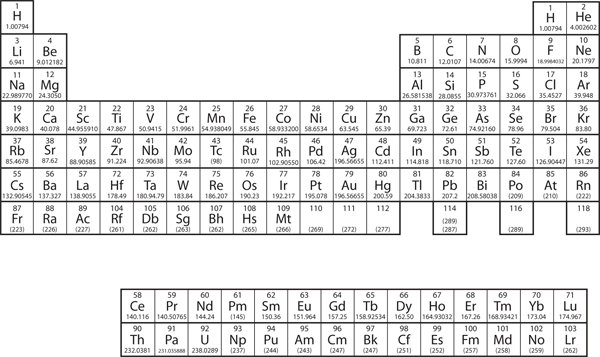
Why does the periodic table take the structure information technology does? The reply is rather simple, if y'all understand electron configurations: the shape of the periodic table mimics the filling of the subshells with electrons.
Let usa outset with H and He. Their electron configurations are 1s 1 and ones two, respectively; with He, the northward = 1 beat is filled. These two elements make upwardly the first row of the periodic table (see Effigy eight.six "The 1s Subshell").
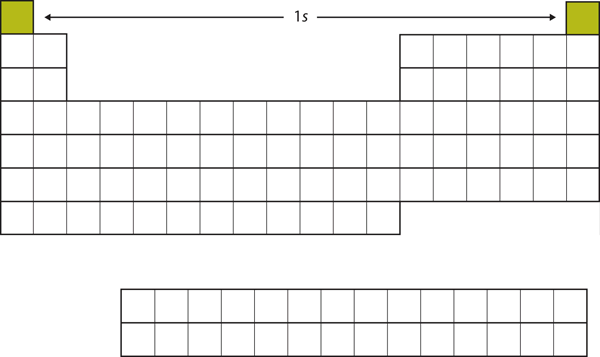
The next two electrons, for Li and Be, would go into the iisouthward subshell. Figure 8.7 "The iis Subshell" shows that these two elements are adjacent on the periodic table.
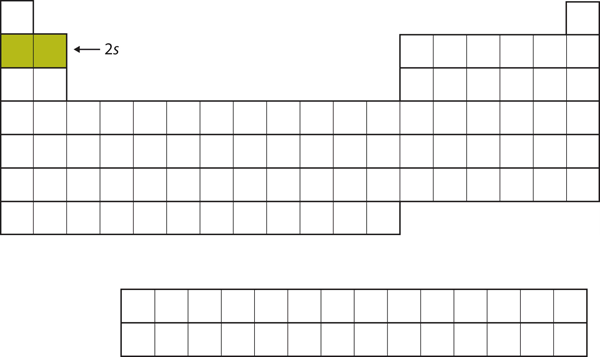
For the next six elements, the twop subshell is being occupied with electrons. On the correct side of the periodic tabular array, these vi elements (B through Ne) are grouped together (Figure eight.14 "The 2p Subshell").
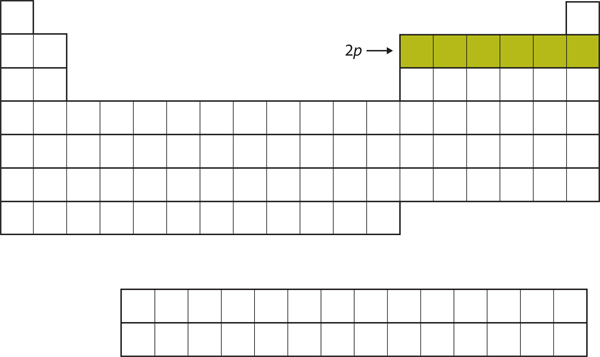
The next subshell to be filled is the threes subshell. The elements when this subshell is being filled, Na and Mg, are back on the left side of the periodic table (Figure 8.9 "The threesouthward Subshell").
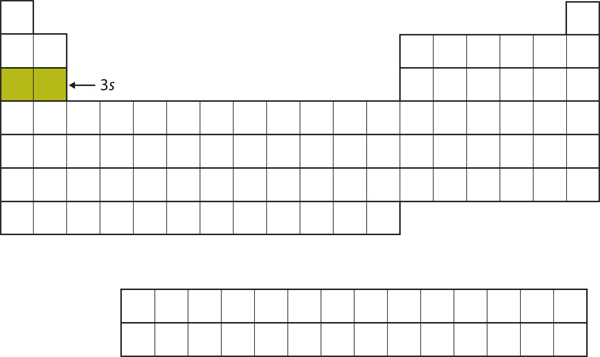
Side by side, the 3p subshell is filled with the side by side half-dozen elements (Effigy 8.10 "The 3p Subshell").
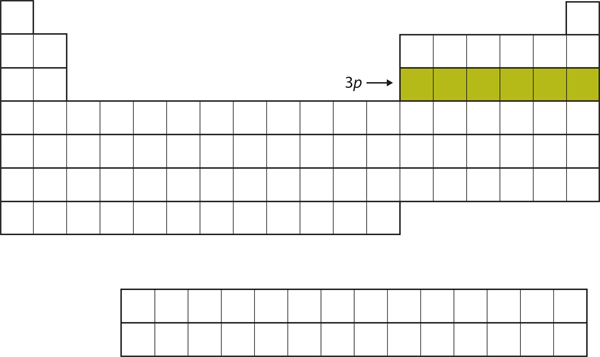
Instead of filling the 3d subshell side by side, electrons go into the 4s subshell, which consists of K and Ca (Figure eight.11 "The 4s Subshell").
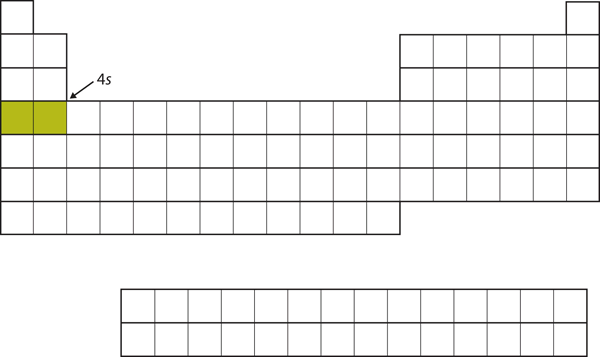
After the ivs subshell is filled, the threed subshell is filled with upwardly to 10 electrons. This explains the department of 10 elements in the centre of the periodic table, which consists of Sc to Zn (Figure eight.12 "The 3d Subshell").
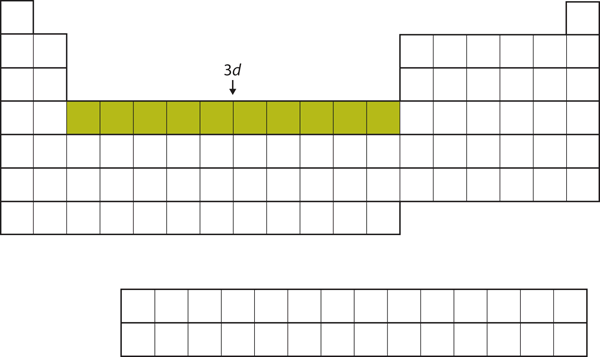
And so forth. As we go across the rows of the periodic table, the overall shape of the tabular array outlines how the electrons are occupying the shells and subshells.
The first two columns on the left side of the periodic table are where the southward subshells are being occupied. Because of this, the first 2 columns of the periodic table are labelled the . Similarly, the are the right-well-nigh six columns of the periodic table, the is the centre 10 columns of the periodic table, while the is the xiv-column department that is commonly depicted as detached from the main trunk of the periodic tabular array. Information technology could be part of the main body, but and then the periodic table would be rather long and cumbersome. Figure eight.13 "Blocks on the Periodic Table" shows the blocks of the periodic table.
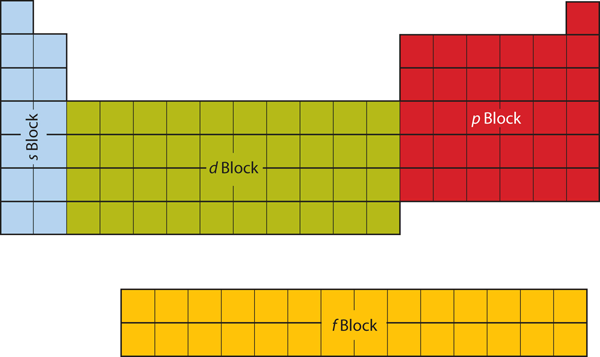
The electrons in the highest-numbered shell, plus any electrons in the final unfilled subshell, are chosen ; the highest-numbered vanquish is called the . (The inner electrons are called core electrons.) The valence electrons largely control the chemistry of an atom. If we look at just the valence beat's electron configuration, we find that in each column, the valence shell'southward electron configuration is the aforementioned. For case, take the elements in the first column of the periodic table: H, Li, Na, One thousand, Rb, and Cs. Their electron configurations (abbreviated for the larger atoms) are every bit follows, with the valence shell electron configuration highlighted:
| Element | Electron Configuration |
|---|---|
| H | onesouth one |
| Li | 1southward twoiis 1 |
| Na | [Ne]threes 1 |
| K | [Ar]4s 1 |
| Rb | [Kr]5south 1 |
| Cs | [Xe]vis ane |
They all accept a similar electron configuration in their valence shells: a unmarried s electron. Considering much of the chemical science of an chemical element is influenced past valence electrons, we would expect that these elements would take similar chemistry — and they do. The organisation of electrons in atoms explains not simply the shape of the periodic table but also the fact that elements in the aforementioned column of the periodic table take like chemical science.
The same concept applies to the other columns of the periodic tabular array. Elements in each column take the same valence shell electron configurations, and the elements have some similar chemic properties. This is strictly truthful for all elements in the s and p blocks. In the d and f blocks, because there are exceptions to the order of filling of subshells with electrons, like valence shells are non absolute in these blocks. However, many similarities do exist in these blocks, so a similarity in chemic properties is expected.
Similarity of valence crush electron configuration implies that nosotros can determine the electron configuration of an atom solely by its position on the periodic table. Consider Se, as shown in Figure 8.14 "Selenium on the Periodic Tabular array." It is in the fourth column of the p block. This means that its electron configuration should finish in a p 4 electron configuration. Indeed, the electron configuration of Se is [Ar]4southward 23d 104p 4, as expected.
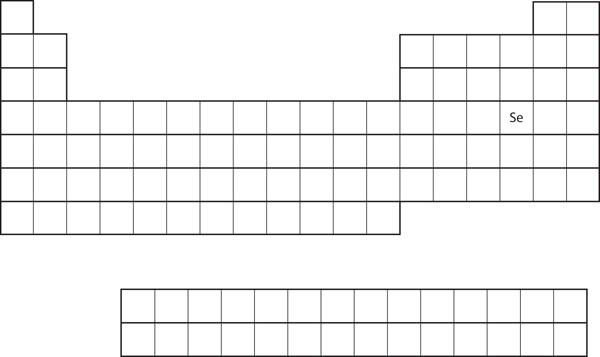
Problem
From the element's position on the periodic tabular array, predict the valence shell electron configuration for each atom. See Figure 8.xv "Diverse Elements on the Periodic Table."
- Ca
- Sn
Solution
- Ca is located in the 2d column of the due south block. We would await that its electron configuration should end with s 2. Calcium'south electron configuration is [Ar]fours two.
- Sn is located in the 2d cavalcade of the p cake, so we expect that its electron configuration would end in p ii. Tin's electron configuration is [Kr]5due south 2ivd 10vp ii.
Test Yourself
From the chemical element's position on the periodic tabular array, predict the valence beat out electron configuration for each cantlet. See Figure 8.15 "Various Elements on the Periodic Tabular array."
- Ti
- Cl
Answer
- [Ar]ivsouthward twoiiid 2
- [Ne]3due south ii3p 5
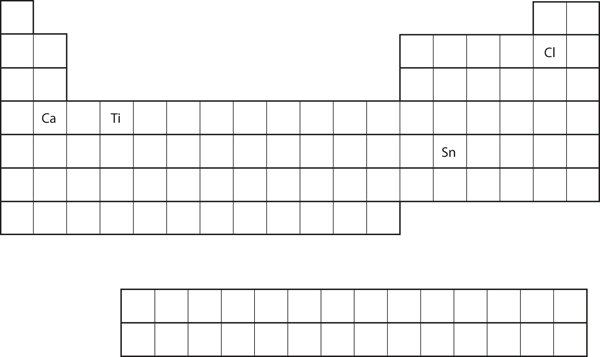
Food and Drink App: Artificial Colours
The colour of objects comes from a dissimilar mechanism than the colours of neon and other belch lights. Although coloured lights produce their colours, objects are coloured considering they preferentially reverberate a certain color from the white low-cal that shines on them. A red tomato, for instance, is brilliant red considering it reflects red low-cal while absorbing all the other colours of the rainbow.
Many foods, such as tomatoes, are highly coloured; in fact, the common argument "yous swallow with your optics first" is an implicit recognition that the visual appeal of nutrient is just as of import equally its taste. Only what about processed foods?
Many candy foods accept food colourings added to them. There are two types of food colourings: natural and bogus. Natural food colourings include caramelized sugar for brown; annatto, turmeric, and saffron for various shades of orangish or yellow; betanin from beets for royal; and even carmine, a deep ruddy dye that is extracted from the cochineal, a pocket-size insect that is a parasite on cacti in Central and South America. (That's correct: you may exist eating issues juice!)
Some colourings are artificial. In the United States, the Food and Drug Administration currently approves just seven compounds as artificial colourings in food, beverages, and cosmetics:
- FD&C Blue #1: Brilliant Blueish FCF
- FD&C Blue #2: Indigotine
- FD&C Green #three: Fast Greenish FCF
- RD&C Ruby #3: Erythrosine
- FD&C Red #xl: Allura Red AC
- FD&C Yellow #5: Tartrazine
- FD&C Yellow #vi: Sunset Xanthous FCF
Lower-numbered colours are no longer on the market or have been removed for various reasons. Typically, these bogus colourings are large molecules that absorb certain colours of calorie-free very strongly, making them useful fifty-fifty at very low concentrations in foods and cosmetics. Even at such low amounts, some critics merits that a small portion of the population (especially children) is sensitive to artificial colourings and urge that their use exist curtailed or halted. All the same, formal studies of artificial colourings and their furnishings on behaviour take been inconclusive or contradictory. Despite this, most people continue to bask processed foods with artificial colouring (like those shown in the accompanying figure).
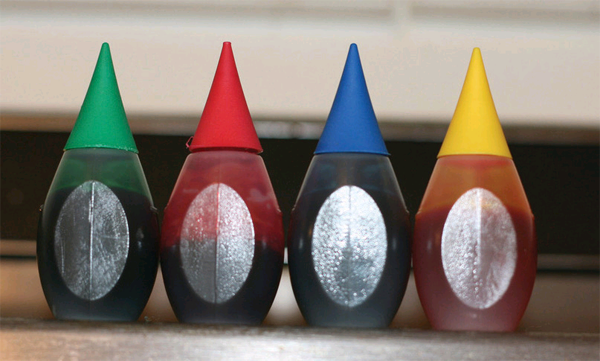
- The organisation of electrons in atoms is responsible for the shape of the periodic table.
- Electron configurations tin be predicted by the position of an atom on the periodic table.
Questions
- Where on the periodic tabular array are southward subshells being occupied by electrons?
- Where on the periodic tabular array are d subshells being occupied by electrons?
- In what cake is Ra found?
- In what block is Br constitute?
- What are the valence shell electron configurations of the elements in the second column of the periodic tabular array?
- What are the valence shell electron configurations of the elements in the adjacent-to-last column of the periodic table?
- What are the valence trounce electron configurations of the elements in the first column of the p block?
- What are the valence beat out electron configurations of the elements in the last cavalcade of the p cake?
- From the chemical element's position on the periodic tabular array, predict the electron configuration of each of the following atoms:
- Sr
- S
- From the chemical element's position on the periodic table, predict the electron configuration of each of the post-obit atoms:
- Atomic number 26
- Ba
- From the element's position on the periodic tabular array, predict the electron configuration of each of the following atoms:
- V
- Ar
- From the element's position on the periodic table, predict the electron configuration of each of the following atoms:
- Cl
- Chiliad
- From the element'south position on the periodic table, predict the electron configuration of each of the following atoms:
- Ge
- C
- From the chemical element's position on the periodic table, predict the electron configuration of each of the post-obit atoms:
- Mg
- I
Answers
- the kickoff two columns
- the south cake
- ns 2
- ns 2 np 1
-
- 1southward 22s ii2p 63s 2iiip 64s 23d xivp 6fivesouth 2
- 1southward 22s 22p half-dozen3due south ii3p 4
-
- 1s 2twos ii2p half-dozenthrees 23p 64s 2threed 3
- is 22s 22p 6threesouth twothreep 6
-
- 1south two2s 22p half-dozenthreesouth 2iiip 64s ii3d 104p 2
- 1south 22s 22p 2
Long Descriptions
Figure viii.15 description: Various elements on the periodic tabular array.
Ca (calcium) is in the 2d column from the left and the fourth row.
Ti (titanium) is in the fourth cavalcade from the left and the fourth row.
Cl (chlorine) is in the second column from the correct and the second row.
Sn (can) is in the 5th column from the right and the fifth row.
[Render to Effigy 8.15]
Media Attributions
- "The Periodic Table" by David W. Brawl © CC Past-NC-SA (Attribution NonCommercial ShareAlike)
- "The 1s Subshell" past David West. Brawl © CC Past-NC-SA (Attribution NonCommercial ShareAlike)
- "The 2s Subshell" by David W. Ball © CC Past-NC-SA (Attribution NonCommercial ShareAlike)
- "The 2p Subshell" past David Due west. Ball © CC BY-NC-SA (Attribution NonCommercial ShareAlike)
- "The 3s Subshell" by David West. Brawl © CC BY-NC-SA (Attribution NonCommercial ShareAlike)
- "The iiip Subshell" past David W. Brawl © CC BY-NC-SA (Attribution NonCommercial ShareAlike)
- "The 4southward Subshell" by David West. Ball © CC By-NC-SA (Attribution NonCommercial ShareAlike)
- "The 3d Subshell" past David W. Ball © CC BY-NC-SA (Attribution NonCommercial ShareAlike)
- "Blocks on the Periodic Table" by David W. Ball © CC By-NC-SA (Attribution NonCommercial ShareAlike)
- "Selenium on the Periodic Table" by David W. Ball © CC Past-NC-SA (Attribution NonCommercial ShareAlike)
- "Various Elements on the Periodic Table" past David W. Brawl © CC BY-NC-SA (Attribution NonCommercial ShareAlike)
- "Food Colouring" by Matthew Bland © CC BY (Attribution)
Source: https://opentextbc.ca/introductorychemistryclone/chapter/electronic-structure-and-the-periodic-table/
Post a Comment for "what would you expect the electron configuration of element 113 to be"